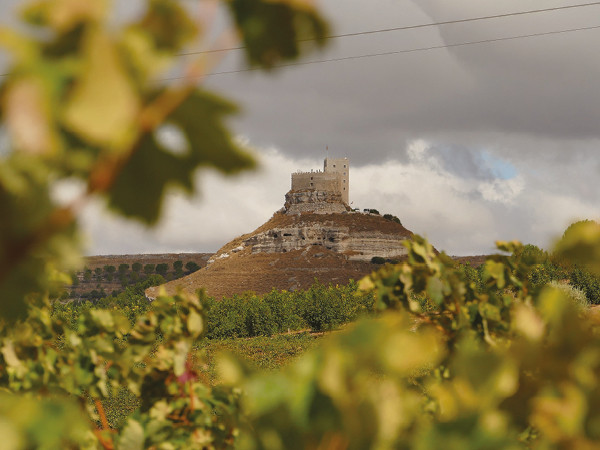
Headline Heroes: Wines with altitude
Ribera del Duero is one of Spain’s biggest triumphs – a fine wine icon in the making. The Castilla y León region has been pivotal throughout the country’s rich history. Vines here have been supplying the Spanish court with superlative red wines for many centuries, and it is also the birthplace of El Cid! Yet when the Ribera del Duero DO (appellation) was created in 1982, there were just nine wineries in this arid corner of north-western Spain.
However, ongoing investment – buoyed by the relentless enthusiasm of the younger generation – has propelled Ribera del Duero to the first division. Today approximately 300 wineries are producing Tempranillo (locally, Tinto Fino) wines of intense aroma, colour and flavour; balanced and impeccably fresh. It is here, in the dramatic plains of Old Castile, that you’ll discover some of Europe’s most exciting – and prestigious – reds.
The topography of the region is highly conducive to premium winemaking. In addition to exceptional soils (clay-limestone and loamy terroir), Ribera del Duero boasts a plethora of high-altitude vineyards. Scaling the heights of winegrowing brings many advantages: producers can maintain freshness in their wines, despite the intense summer heat, thanks to diurnal temperature variation. But it also has a decisive impact on berry growth, phenolic ripeness and tannin development. Demystifying this complex subject has become a key focus for the Consejo Regulador’s promotional activity in 2023: Wines with Altitude.
- Read more: Spain Report - Reinvigorating Ribera
“The focus of this activity is to explore – and understand – the effects of altitude on vines and winemaking. High-altitude viticulture results in increased UV rays, which forces the grapes to develop thicker skins, leading to great colour concentration and stronger tannins,” explains Pablo Baquera, marketing director, Ribera del Duero Consejo Regulador.
He continues: “Our complex land and harsh climate provide us with unique conditions to produce, at high altitude, grapes of exceptional quality. The unique characteristics of the soils and climate in which our vines are cultivated serve to produce the best fruit.”
Jeroboams wine director Peter Mitchell MW agrees that vineyard elevation is one of the DO’s most valuable natural resources. “Ribera del Duero is now seen by enthusiasts as a high-quality wine region. The best way to market the style is through its potent USP of freshness and power; it is one of only a few wines that manage to have as much ripeness and extract as it does while maintaining startling clarity and freshness, due to the high diurnal temperature variation,” he says.
Mitchell adds that he has observed consumers move away from heavier wines “full of dried fruit notes and those which lack natural freshness”. Instead, they reportedly now appreciate deep and powerful wines that still have fresh fruit. The region continues to capitalise on this trend, producing balanced and fresh wines for a modern audience.
Strolling through the vineyards of Ribera del Duero, the thought quickly occurs that innovation is the lifeblood of this relatively nascent DO. Indeed, there is a growing movement to experiment with alternative vessels, such as tinajas (small clay jars) and amphorae. Many of the region’s top labels, however, are aged in high-quality oak barrels for more than 12 months.
Meanwhile the preservation of centenarian bush vines continues apace. With continued innovation and nurturing of the region’s old vines, alongside increased awareness of why altitude matters, Ribera del Duero’s star looks set to shine brighter. Onwards and upwards.
Q&A (Paid Promotion): Pablo Baquera marketing director, Ribera del Duero Consejo Regulador
Please tell us more about the Wines with Altitude campaign: what key messages do you want to share with consumers?
It’s all about altitude this year, highlighting the extreme climatic conditions and terrains that winemakers in Ribera del Duero have to navigate in search of perfection. One of the campaign’s key goals is to explore how increased diurnal range and more ventilation slows ripening and preserves acidity, and provides a better expression of the grape variety’s true characteristics. Altitude, together with soils and climate, is what makes the wines so exceptional and Ribera del Duero is one of the highest wine regions in the northern hemisphere with more than 70% of the vineyards located at 800m above sea level or higher.
What are the key goals and objectives for this campaign?
Showcasing the quality and diversity on offer and highlighting what makes the region’s wines so exceptional.
What are Ribera del Duero’s unique selling points for consumers unfamiliar with the region and its wines, in your opinion?
There are several. One could be described as “year-round care”: winegrowers and winemakers work with great respect for what the land has to offer. They combine affection, care, patience, dedication and commitment with know-how, tradition and cutting-edge technology. They know that the more challenging their work, the greater the reward. In addition, the competing demands of terroir, winegrowers and winemakers with their love and dedication to both land and wine, produce exceptional wines that are recognised around the world. Our wines are made to excite, they are unique, full of character and, above all, are made to be enjoyed.





